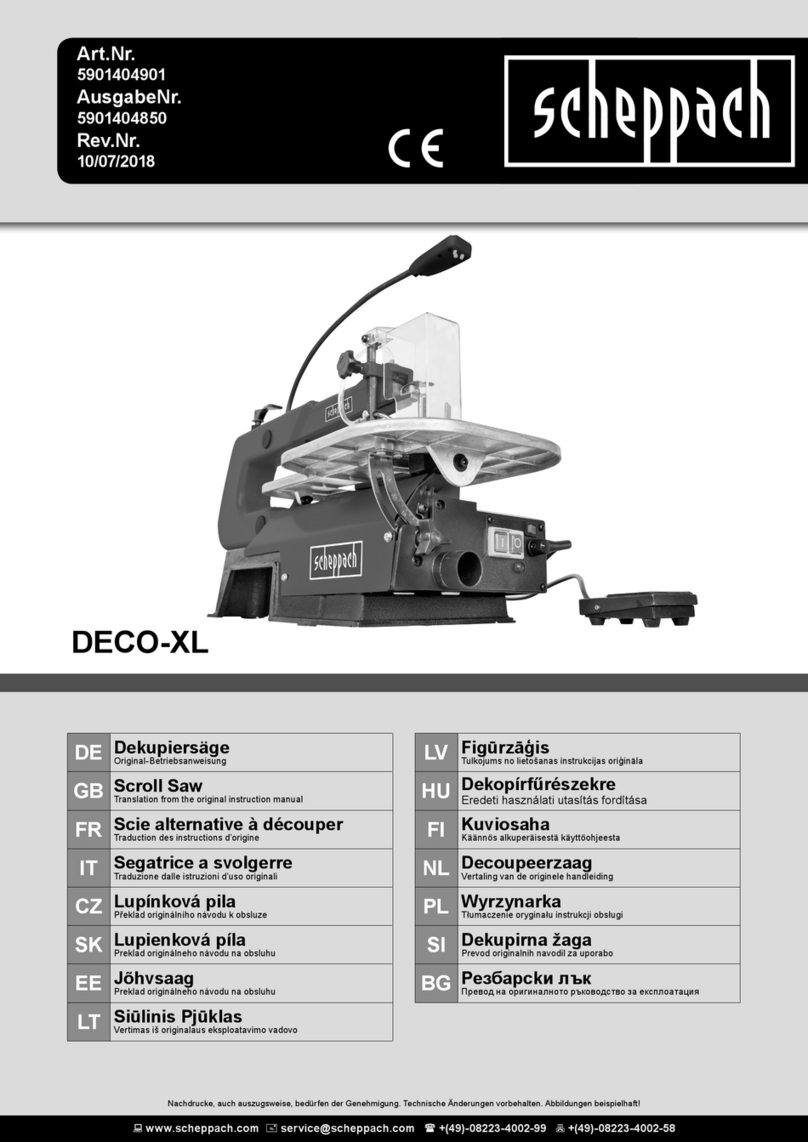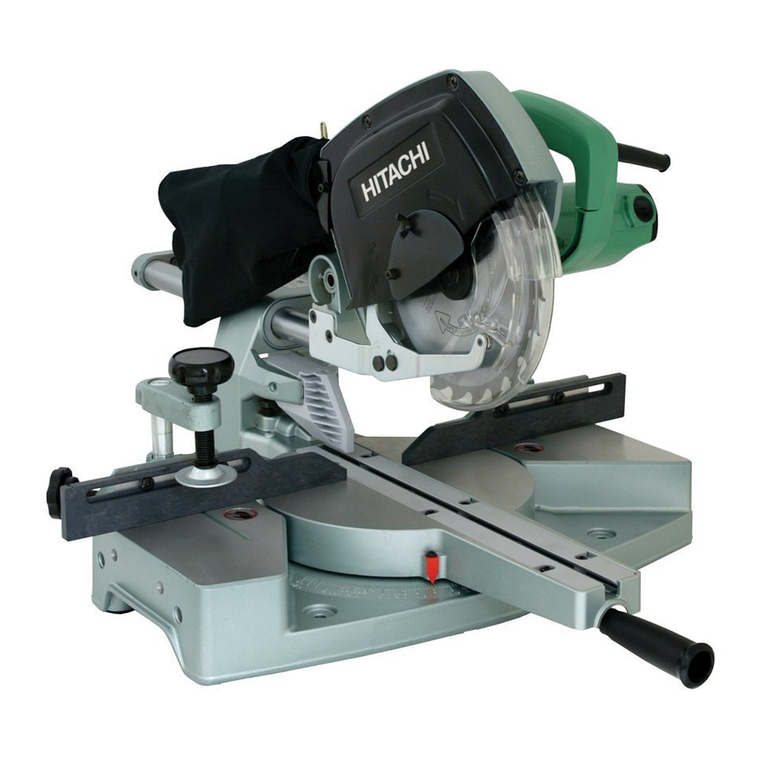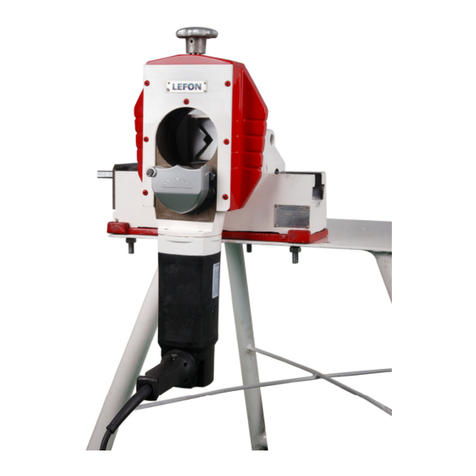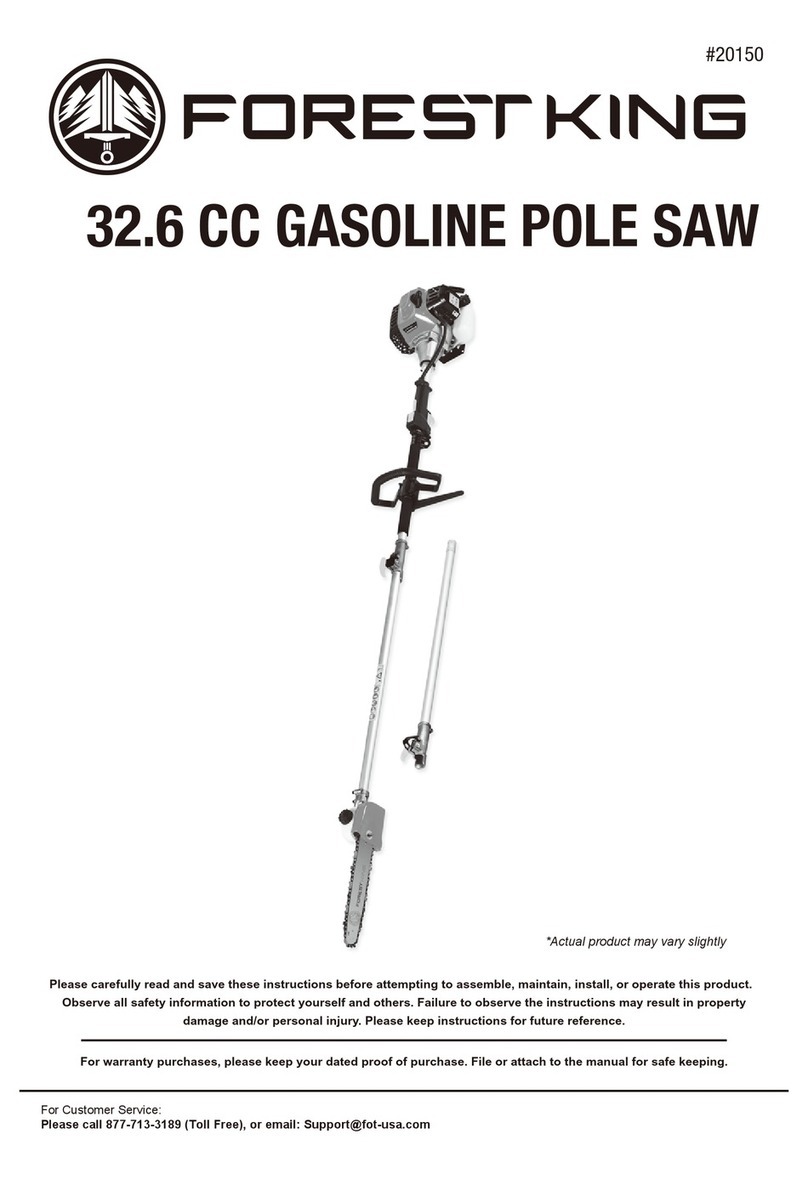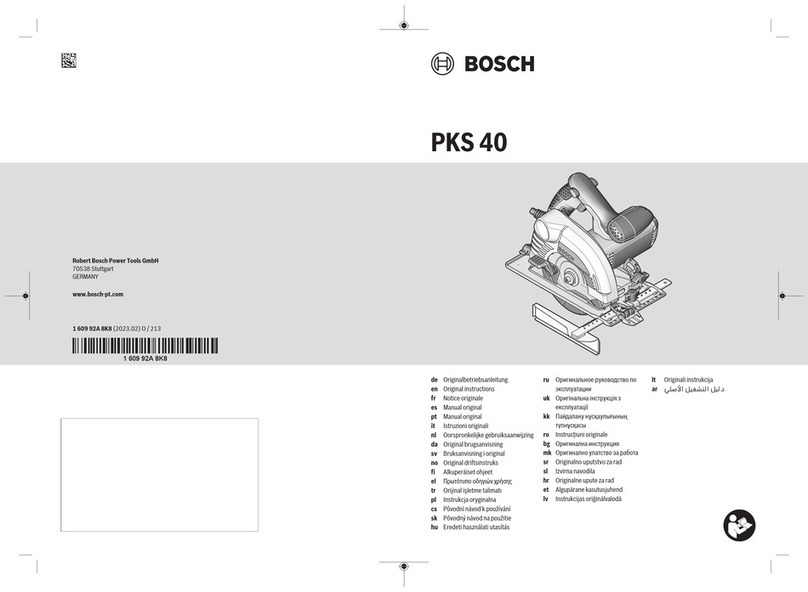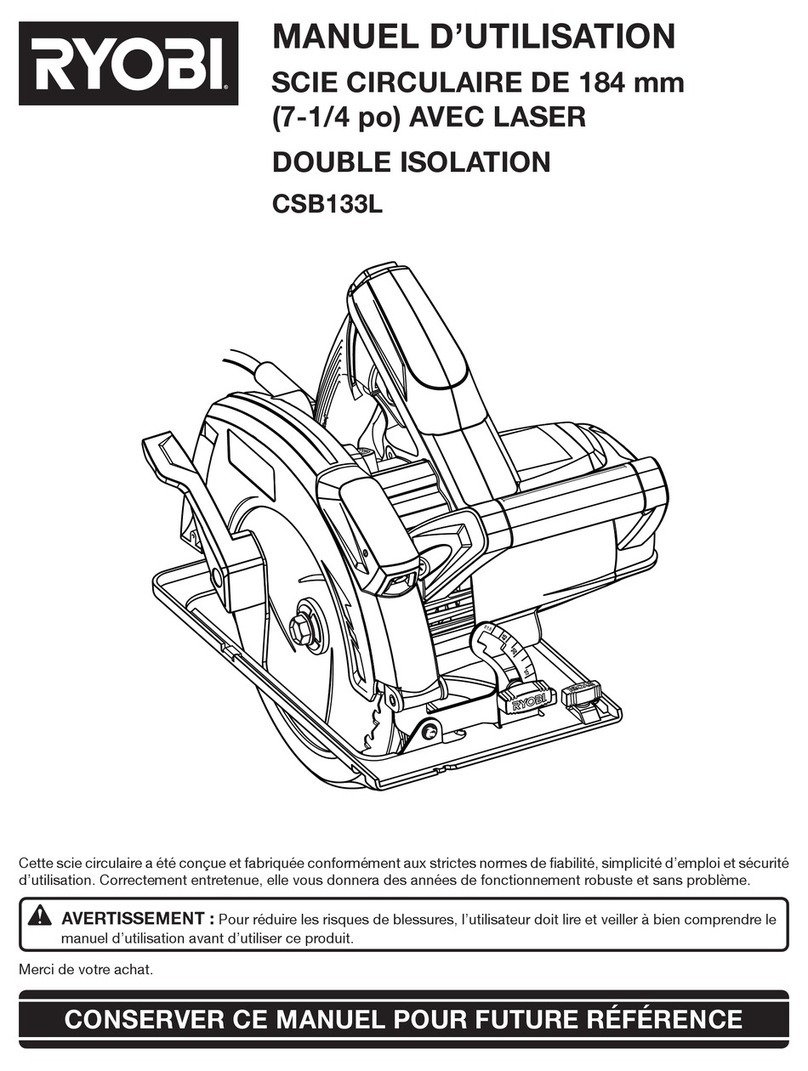Mega Machine BS-250HAS User manual

Automatic BANDSAWS
BS-250HAS
INSTRUCTION MANUAL
MEGA MACHINE CO., LTD.
DOC NO:BS250HAS-100.U
CTRL NO:06
UPDATE:1998/7/23
DOC VER:A2

FOREWORD
We hope that the owner of this heavy-duty bandsawing machine will have years of trouble-free
service. The machine has been built to the highest standards to enable fast accurate cutting to be obtained.
In order that the best results can be achieved from your MEGA band saw we would ask all operators
and maintenance engineers to READ THIS MANUAL CAREFULLY BEFORE STARTING
UP THE MACHINE. The manual contains full instructions on installation, operation, lubrication,
maintenance and trouble-shooting.
As MEGA MACHINE COMPANY LIMITED is constantly improving the design of its
machines, there may be some instance where this book differs somewhat from the machine with
which you are concerned. So, always quote the Serial Number of your machine, when ordering
spare parts or in correspondence relating to the machine.
MODEL : BS250HAS
Serial Number :
Request for service and spare parts should be made to :
ADDRESS: NO. 180, INDUSTRIAL ROAD, TAI-PING CITY, 41154 TAICHUNG,
TAIWAN R. O. C.
http: www.bandsaw.com.tw
TEL: 886 4 22712877(PRES.) FAX:886 4 22715016

TABLE OF CONTENTS
Item Unit Page
1 Introductory Illustrations 1-1
1.1 Principal parts and outside Dimension 1-1
2 Specifications
2.1 Specifications 2-1
2.2 Standard Accessories 2-1
3 Installation
3.1 Moving and lifting 3-1
3.2 Foundation layout and Set-up 3-2
3.2.1 Foundation 3-2
3.2.2 Leveling 3-3
3.2.3 Cleaning and oiling 3-3
3.2.4 Power Source Connection 3-4
4 Operation
4.1 Control Panel 4-1
4.2 Operating preparation 4-3
4.3 Manual Operation 4-4
4.4 Automatic operation 4-5
4.5 Special Operation 4-5
4.6 Break -In Operation 4-5
5 Maintenance
5.1 Hydraulic Circuit 5-1
5.2 Oiling and Lubrication 5-2
5.3 Others 5-3
6 Trouble Shooting Guide
6.1 Sawing Problems and Solution 6-1
6.2 Minor Operating Troubles and Remedies 6-2
6.3 Error information 6-3
7 Reference Charts
7.1 Standard cutting Chart 7-1
7.2 Standard cutting Chart 7-2
7.3 Standard cutting Chart 7-3
Electrical Circuit

1. INTRODUCTORY ILLUSTRATIONS
1.1 Principal Parts
1 Coolant Pump 10 Hydraulic Blade Tension Set
2 Main Motor 11 Saw Frame
3 Pulley Cover 12 Guide Arm
4 Electric Control Box 13 Guide Arms Slide
5 Stock Tray 14 Quick Approach Rod
6 Chip Conveyance 15 Feed Assembly
7 Lift Cylinder 16 Slide Shaft
8 Water Trough 17 Feed Cylinder
9 Oil Tank 18 Vise
1 - 1

2 SPECIFICATIONS
2.1 SPECIFICATIONS
MODEL
SPECIFICATIONS BS-250HAS
(Mm) φ260□300W*180H □280W*250H
Cutting Capacity (In) φ10□12*7 □11*10
Bundle Cutting (Mm) 200W*140H 8“*5 1/2”
(Mm) 34*1.1*3660
Blade Size (In) 1 1/4*0.042*144
(M/Min) 25, 32, 42, 55, 70, 80 Variable Speed 20-80
Blade Speed (F/Min) 82, 105, 138, 180, 230, 260 Variable Speed 65-260
(KW) Blade-2.25 HYD-0.75 Coolant-0.1
Motor Output (HP) Blade-3 HYD-1 Coolant- 1/8,
(Mm) 2040*2012*1500
Shipping Volume (Ft) 6.7L*6.6w*5.0H
Weight Net/Gross KG, lb 1380 KG / 1610 lb. 3036 KG / 3542 lb.
Specifications subject to change without notice for improvement and modification.
2.2 STANDARD ACCESSORIES
1. Tools with tool box .............………….……..……....... 1 set
2. 7 ft.(2M) long roller table ...…………………..…......... 1 set
3. Band-cleaning wire brush ...…………………..….......... 1 pieces
4. Band saw blade .................…………………..……....... 1 piece
5. Vertical guide rollers .............………………..……….... 1 set
6. Instruction manual .............………………….……........ 1 copy
2 - 1

3. INSTALLATION :
3.1 Moving and Lifting :
Unpack your machine carefully , and use a crane or forklift to set it in position.
If a crane is used to lift the machine attach the lifting cable carefully to the machine as shown in
the fig 2. If forklift is used then fig 3.
Sufficient space should be left around the machine to allow safe handling of materials , and
inspection and maintenance operation. Should there be other machinery causing vibration or dust
near your machine precautions must be taken to keep your machine free of vibration and dust.
(1) Use Crane :
Fig 2
(2) Use Forklift :
Fig 3
3 – 1

3.2 Foundation layout and set-up :
3.2.1 Foundation :
The foundation should be constructed of reinforced concrete and must be level and flat. After
the proper leveling position has been obtained , anchor the machine with anchor bolts.
The position of anchor bolts and floor dimensions are shown in fig 4:
□Contact portion with floor
○Position of anchor bolts
Fig. 4
※All leveling bolts should support the weight of the
machine evenly .
3 – 2

3.2.2 Leveling :
The production accuracy of all precision machinery depends on the accuracy which the machine
is installed . Manufacturing tolerance of the machine can only be guaranteed if the machine is firmly
and properly installed . Once the machine is lowered on the prepared foundation . Machinist levels
should be used alternately on the vice slide plates and the work feed table , and adjust the left-and-
right and fore-and-aft level of the machine with leveling bolt .
Leveling as fig 5 below :
FIG 5
The fore-and-aft level should be adjusted so that the level of the rear end is approximately 10 mm
(3/8" - 1/2") higher than the level of the front end , to provide proper return of the cutting fluid , and
easy operation of car feeding .
The left-and-right level should be adjusted so that the level of the left end is approximately 3 mm
(1/8") higher than the level of the right end , to provide proper return of the cutting fluid , After the
proper leveling position has been obtained anchor the machine with anchor bolts .
Caution : All leveling bolts should support the weight of the machine evenly .
3.2.3 Cleaning and oiling :
After the machine has been placed in position , thoroughly remove its rust preventive coating using
a suitable cleaning solvent and then apply a coat of machine oil . To clean the machine , Kerosene is
preferable to gasoline . It does not evaporate and level dried slushy compound on finished surfaces.
Rags are better than waste as they leave no lint or strings. The machine as received by you. has been
completely drained of all oil. Before any attempt is made to run it .... Before any motor connections
are made .... every detail of the following oiling instruction must be complied with. Refer to the oiling
chart in chapter 7.
Especially , don't forget to fill up the cutting fluid mixture. Usually , the ratio of cutting fluid to
Water should be 1:30 - 1:50. Check the sight gauge to ascertain the fluid level in the tank every day.
Transmission gear box, bar feed gear box, hydraulic oil tank should to topped up monthly. Oil
levels should be strictly observed, for it is of primary importance for proper operation and long lift .
3 - 3

3.2.4 Power Source Connection :
A. Power Source - This machine is equipped with 3HP main motor and 1HP hydraulic motor ,
and 1/8HP coolant motor. Connect the power supply cable to the circuit breaker(N.F.B.)
terminals. The power supply to your machine should agree with the wring voltage that is
indicated on the label attached to the electrical enclosure and main motor.
B. Earth - Be sure to connect the earth cable to the earth terminal.
C. Starting - After making the necessary wiring connections, turn the power switch on the control
panel clockwise to turn power on, depress the vice limit switch (if necessary, e.g. if there is no
stock bar clamped in the vice) and push the button to see if the saw head moves upward. If the
saw head does not rise , the hydraulic pump motor is rotating in the wrong direction. If the motor
runs in the wrong direction, turn off the power switch and disconnect the power supply cable,
Then interchange any two phase connections.
3 - 4

4. OPERATION (Type 1)
4.1 Control Panel
(1) PNC Control Panel
Cutting Piece Counter – This counter is
used to preset the number of cuts required
on the automatic operation. When the
counter reaches the preset number, the
machine stops automatically . To activate
the counter, preset the counter switch with
number at least “1”.
Clear – This key is used to clear the
counted number cut already and to have
new number input available.
Multiple stroke feed counter – This
counter makes it possible to multiply the number of index cycles when off-cut pieces longer than 500mm
are required. Maximum 9-time stroke can be set.
Blade speed LED-Display -- This blade speed tachometer indicates how fast the saw blade is running in
meter per minute by LED display.
To see digital cut length counter
L (length req.) + K (blade thickness)
S = N (multiple feed times) - K
EXAMPLE:
1200 +1.5
S = 3 -1.5 = 400.5-1.5 = 399
L = Required cut length N = Multiple feeding times
K = Cutting loss ( Blade thickness ) S = Digital counter length setting
4 - 1

Total bar feed needed = length + blade thickness
Single step feed = length + K
Multiple step feed only needs 1 allowance for blade
Thickness ...hence…L + K divided by number of steps
Then less K = Digital counter setting length….
(2) PILOT LAMP -- This light will comes on when the power supply is on.
(3) EMERGENCY STOP -- This switch is used for emergency case to stop the machine only.
Turn this switch clockwise makes power source on. When this switch is pressed, all machine's operation
stop immediately.
(4) HYDRAULIC "ON" BUTTON -- When this button is depressed, the hydraulic pump motor operates.
(5) POWER SWITCH OFF -- This switch is used for turning off the power by depressing it.
(6) FRONT INCHING OPEN SWITCH -- depress switch No.6for inching opening of the front vise jaw.
(7) AUTO - MANUAL SELECTOR -- For continuous cutting , turn this selector to left "AUTO".
To individually operate each function, turn this switch to right "manual".
(8) FRONT VISE SWITCH -- This switch control the front vise jaws in manual mode, switch it to the
left makes the front vise in open mode, depress switch No.6for inching opening of the front vise jaw,
and witched to the right makes the front vise clamp.
(9) BLADE DRIVE BUTTON -- When this button is pressed, both the saw blade motor and the cutting
fluid pump operate and saw head begins to descend. The saw head descends quickly until the feeler of the
quick approach device comes into contact with the workpiece and thereafter, it will descend at the
designated cutting speed.
(10) REAR VISE SWITCH -- This switch control the rear vise jaws in manual mode, switched to the left
makes the front vise open. and switched to the right makes the front vise clamp.
(11) MANUAL FEED FORWARD BUTTON --When this button is pressed the workpiece moves
forward. The workpiece stops advancing when the button is released.
NOTE: Turn (8) VISE SWITCH right position before depress switch (9) BLADE DRIVE to cutting.
(12) MANUAL FEED BACKWARD BUTTON --When this button is pressed the workpiece moves
backward. The workpiece stops moving when the button is released.
NOTE: Don't depress (11) and (12) two switches, if the workpiece are clamped by both front and
rear vises in the meantime.
(13) QUICK APPROACH BUTTON -- While this button is pressed, the saw head descends quickly.
This button is used to cause the saw blade to approach the work quickly when the saw blade is at a
distance from the workpiece. When the feeler of the quick approach device comes into contact with
the work, the saw head stops descending at that position even this button is still pressed.
(14) SAW FRAME RAISE BUTTON -- When this button is pressed, the saw blade motor stops and the
saw head ascends. The saw head stops ascending at that position when the button is released.
(15) WORK BEAM LIGHT SWITCH -- When this switch is set at "1" the work light illuminates.
(16) AUTO CHIP CONVEYOR & COOLANT SWITCH -- When this switch is set at "1" the cutting
fluid pump operates and cutting fluid will be injected even though the saw blade motor is not in
operation. Use this switch when removing saw chips with the cutting fluid (without the blade running).
(17). INVERTER CONTROL KNOB -- Please turn left for being slow speed wanted, turn right for
being fast speed wanted. Please refer to (JPS) Inverter Instruction Manual or Please refer to (TOSHIBA)
Inverter Instruction Manual
(18) FEED RATE CONTROL KNOB -- When this control dial is turned clockwise the feed rate of
the cutting increases, when it is turned counter clockwise, the feed rate decreases.
(19) CUTTING PRESSURE CONTROL KNOB -- When this control dial is turned clockwise the
cutting pressure increases, when it is turned count clockwise, the cutting pressure decreases.
4 – 2

4. OPERATION (Type 2)
4.1 Control Panel
(1) PNC Control Panel
Cutting Piece Counter – This counter is used to preset the number of cuts required on the automatic
operation. When the counter reaches the preset number, the machine stops automatically . To activate the
counter, preset the counter switch with number at least “1”.
Clear – This key is used to clear the counted number cut already and to have new number input available.
Multiple stroke feed counter – This counter makes it possible to multiply the number of index cycles
when off-cut pieces longer than 500mm are required. Maximum 9-time stroke can be set.
Blade speed LED-Display -- This blade speed tachometer indicates how fast the saw blade is running in
meter per minute by LED display.
To see digital cut length counter
L (length req.) + K (blade thickness)
S = N (multiple feed times) - K
EXAMPLE:
1200 +1.5
S = 3 -1.5 = 400.5-1.5 = 399
L = Required cut length N = Multiple feeding times
K = Cutting loss ( Blade thickness ) S = Digital counter length setting
4 - 1

(2) PILOT LAMP -- This light will comes on when the power supply is on.
(3) EMERGENCY STOP -- This switch is used for emergency case to stop the machine only.
Turn this switch clockwise makes power source on. When this switch is pressed, all machine's operation
stop immediately.
(4) POWER SWITCH ON -- This switch is used for turning on the power by depressing it.
(5) POWER SWITCH OFF -- This switch is used for turning off the power by depressing it.
(6) HYDRAULIC "ON" BUTTON -- When this button is depressed, the hydraulic pump motor operates.
(7) BLADE DRIVE BUTTON -- When this button is pressed, both the saw blade motor and the cutting
fluid pump operate and saw head begins to descend. The saw head descends quickly until the feeler of
the quick approach device comes into contact with the workpiece and thereafter, it will descend at the
designated cutting speed.
(8) FRONT VISE SWITCH -- This switch control the front vise jaws in manual mode, switch it to the
left makes the front vise in open mode, depress switch No.9for inching opening of the front vise jaw,
and witched to the right makes the front vise clamp.
(9) FRONT INCHING OPEN SWITCH -- depress switch No.9for inching opening of the front vise jaw.
(10) REAR VISE SWITCH -- This switch control the rear vise jaws in manual mode, switched to the left
makes the front vise open. and switched to the right makes the front vise clamp.
(11) AUTO - MANUAL SELECTOR -- For continuous cutting , turn this selector to left "AUTO".
To individually operate each function, turn this switch to right "manual".
(12) MANUAL FEED FORWARD --When this button is pressed the workpiece moves forward.
The workpiece stops advancing when the button is released.
NOTE: Turn (8) VISE SWITCH right position before depress switch (7) BLADE DRIVE to cutting.
(13) MANUAL FEED BACKWARD --When this button is pressed the workpiece moves backward.
The workpiece stops moving when the button is released.
NOTE: Don't depress (12) and (13) two switches, if the workpiece are clamped by both front and
rear vises in the meantime.
(14) QUICK APPROACH BUTTON -- While this button is pressed, the saw head descends quickly.
This button is used to cause the saw blade to approach the work quickly when the saw blade is at a
distance from the workpiece. When the feeler of the quick approach device comes into contact with
the work, the saw head stops descending at that position even this button is still pressed.
(15) SAW FRAME RAISE BUTTON -- When this button is pressed, the saw blade motor stops and the
saw head ascends. The saw head stops ascending at that position when the button is released.
(16) WORK BEAM LIGHT SWITCH -- When this switch is set at "1" the work light illuminates.
(17) AUTO CHIP CONVEYOR & COOLANT SWITCH -- When this switch is set at "1" the cutting
fluid pump operates and cutting fluid will be injected even though the saw blade motor is not in
operation.
Use this switch when removing saw chips with the cutting fluid (without the blade running).
(18) CUTTING PRESSURE CONTROL KNOB -- When this control dial is turned clockwise the
cutting pressure increases, when it is turned count clockwise, the cutting pressure decreases.
(19) FEED RATE CONTROL KNOB -- When this control dial is turned clockwise the feed rate of
the cutting increases, when it is turned counter clockwise, the feed rate decreases.
4 -2

4.2 OPERATING PREPARATION
There are several steps will be taken before start the machine.
(1) CHOOSE PROPER SAW BLADE :
Select the saw blade best suited to the workpiece to be cut, Size and shape of the workpiece , and
type of material should all be considered when selecting the saw blade to be used . There is a reference
chart in chapter 7 which can help you to select the right saw blade and cutting conditions .
(2) UNPACK THE SAW BLADE :
Usually the saw blade is packed in 3 circle ,unpack it one circle first grip the part to release another 2
circles gradually , tear off the saw-cap protective shield , inspect the blade teeth , make sure that the
cutting edge of the blade teeth point to the right . If they point to the left the blade should be turned over.
(3) PLACE THE SAW BLADE ONTO BOTH THE DRIVE AND DRIVEN WHEELS ----
a. Turn the hydraulic blade tension handle clockwise , to fully loosen the driven wheel .
b. Open both the drive and driven wheel covers , place the saw blade onto both the drive and driven
wheels. Check the cutting edge of the saw blade , to ensure that it point to the right.
c. Insert the saw blade into both the left and right blade guides so that the back edge of the saw blade
touches the back-up roller of each guide .
d. The back edge of the saw blade should make contact with the flange of the drive and driven wheel ,
turn count -clockwise the hydraulic blade tension handle to tighten the saw blade , Then the blade
is properly tensioned .
e. Don't forget to tighten the insert adjusting screw .
(4) WORKPIECE CLAMPING :
a. Raise the saw frame , open the vise , place the workpiece on the roller table .
b. Gently push the workpiece into the roller-feed vise, taking care not hit the feed rollers.
c. Clamp the workpiece in vise.
(5) ADJUST THE BLADE GUIDE ARMS :
Properly position the blade guide arms according to the diameter (or the width) of the workpiece to be cut.
a. loosen the insert adjusting screw.
b. loosen the lock lever of the blade guide arm, and manually move the blade guide arm to suit the width of
material using the scale provided.
c. After adjusting the blade guide arm position ,tighten the lock lever.
d. Finger tighten the insert adjusting screw.
(6) ADJUST THE POSITION OFTHE WIRE BRUSH :
a. loosen the lock lever of the wire brush case.
b. Manually move the wire brush case so that wire brush just contacts the cutting edge of the saw blade.
c. Tighten the lock lever.
(7) ADJUST THE FEED RATE :
Select suitable feed rate for the workpiece to be cut. This varies according to the size and shape of the
workpiece, type of material , and what type of saw blade is being used. As a guide hard materias, wide
workpiece or structural sections and tubing have to be cut at a slower rate that mild steel bar.
As concerns the saw blade , high speed steel is better than carbon steel, and bi-metal alloy is better than
high speed steel. Roughly the ratio of feed speeds could be 1:2:3
4 – 3

(8) CUTTING LENGTH PRESET :
To preset the length of the workpiece to be cut ,use the precise cutting piece counter which is at front
leftside of the machine.
a. Turn the handle wheel and watch the counter to the length you want to cut. The calibration is 0.10
mm.for example: 400.1 mm
b. Tighten the lock screw.
(9) SELECT THE SAW BLADE SPEED :
There are 6 speeds provided : 25, 32, 42, 55, 70, 80 M/min
If a optional variable speed drive is equipped the speed to be 20 to 80 M/Min steplessly.
4.3 MANUAL OPERATION :
Place the workpiece to be cut on the work table , decide how long you want the off-cut , and carry
out all the procedures as described above in [2] Operating Preparation.
(1) Depress the RAISE button to lift the saw frame until the cutting edge of the saw blade clears the
workpiece by 1/2 to 3/4 inch.
(2) Turn the AUTO-MANUAL selector to manual.
(3) Clamp the workpiece.
(4) Adjust the spacing of the blade guide arms.
(5) Preset the required cutting length of the workpiece.
(6) Depress BAR FEED PORWARD button until the workpiece touch the bar stop feeler.
(7) Adjust the FEED RATE.
(8) Depress BLADE DRIVE button to start both the saw blade motor and the cutting fluid pump and the
saw frame begins to descend.
(9) After completion of the cut saw blade stops at the lower limit position.
(10) Depress the RAISE button to cut next piece again.
*. Before you start to cut the workpiece, you must inspect that....
*. The workpiece is well clamped.
*. The saw blade is suitable for the material being cut.
*. The feed rate is suitable for the material being cut.
*. The speed of the saw blade is suitable for the material being cut.
*. The insert adjusting screw and the lock lovers of the blade guide arms are all tightened.
*. Sufficient tension is placed on the saw blade.
*. The wire brush is properly positioned.
*. There is sufficient cutting fluid in good condition.
*. The off-cut length is as required.
4 – 4

4.4 AUTOMATIC OPERATION :
Having finished all the procedures described above in (2) Operating Preparation ,and with the
workpiece to be cut placed in the vise of the machine , but NOT under the saw blade.
(1) Turn the AUTO-MANUAL selector to auto.
(2) Depress the QUICK APPROACH switch to make the saw frame descend quickly to touch the lower
limit position , it will then rise automatically to the freight preset.
(3) Make any necessary adjustments to HEIGHT SELECTOR to ensure that the saw blade clears the
material by 1/2 to 3/4 inch then repeat (2) above to check setting.
(4) Depress BAR FEED FORWARD button until the workpiece touches the bar stop feeler.
(5) Preset the number of cuts required.
(6) Depress the BLADE DRIVE button to start both the saw blade motor and the cutting fluid pump.
The saw frame begins to descend to cut workpiece.
(7) After the required number of cut has been completed, the saw frame will lift to the raised position
and all machine operation will stop.
(8) The machine will automatically stop, when the workpiece is so short that it can no longer be
automatically feed.
4.5 SPECIAL OPERATION :
(1) While you are cutting a workpiece, if the saw blade suddenly jams in the workpiece, depress the
FRAME RAISE button to lift the saw frame immediately.
(2) The saw blade jamming in the workpiece is most likely because of :
a. Slippage occurring between saw blade and drive wheel. Tension placed on the saw blade is not
sufficient.
b. Slippage occurring between drive belt and motor pulley. Tension on drive belt is not sufficient or
belt is worn.
c. Broken teeth on saw blade.
d. Too blunt saw blade.
e. Too fine tooth spacing on saw blade for material being cut.
f. Too fast feed rate for material being cut and blade used.
4.6 BREAK-IN OPERATION:
When a new blade is used , be sure to first break in the blade before using it for extended operation.
Failure to break in the blade will shorten the service lift of the blade ,and result in less than optimum
efficiency. To break in the blade ,proceed as follow :
(1) Reduce the blade speed setting to one half of its normal setting .
(2) Lengthen the time required for cutting to 2-3 times that of normal.
(3) The break-in operation can be considered sufficient if all unusual noises or metallic sounds have
been eliminated. (For instance, to completely break in the blade, a minimum of five complete cuts
of a 200mm (8 ins) diameter work- piece will be required.)
(4) After the break-in operation has been completed, return the blade speed and feed rate to their
normal setting.
4 – 5

AMPLIFYING VALVE
(1.) THE OUTLINESAND HYDRAULIC CIRCUITS:
(2.) SET-UP
A. The hydraulic pressure indicated in line <p> should be kept in constant during the whole stroke
of the lifting cylinder, i.e. Between the very top and bottom position of the swinging saw frame.
we use springs <r> inside of lifting cylinder to balance/compensate the pressure changes (pressure
varies due to saw frame swinging up and down ) in line <p>. above procedures have been done in
our factory before machine dispatched , now for checking test, please dry run the machine by raising
the saw frame to the very top position and push the saw blade drive button, and having the quick
approach rod lifted (limit switch un-touched), then check the hydraulic pressure in line <p> by
reading the pressure gauge at line <p> to see if the pressure readings keep the same during the whole
stroke.
(maximum 1 kg/sq.cm varies allowed) the pressure reading should be as follows:
8 KG/SQ.CM ............250HAS/300HAS MODELS
10 KG/SQ.CM ............360HAS/400HAS/450HAS MODELS
4 -6

B. Re-zeroing knob "a" & "b" on the amplifying valve:
For zeroing knob "a", there is a hydraulic pressure gauge as drawing <S> needed, Please plug it
onto the outlet on the amplifying valve.
Pressure read at line <p> as the primary pressure............pressure <p>
Pressure read at amplifying valve as the secondary pressure………...pressure <s>
The primary pressure should be kept the same reading, and the secondary pressure can be adjusted
by turning knob "b" for cutting pressure settings zeroing knob "a" :
------------------
Dry run the machine as stated in above paragraph,
Turn knob "b" while reading pressure <s>, If there is any pressure can be read, then turn knob "a"
While watching saw frame, if the saw frame shall stand still there without coming down, then there is
the zero position of the knob "a" ( zero feed-rate ), check the " △" mark on the knob "a" to see if
this mark pointing to "0" position. If not, loosen set screw and zeroing it ( Please make sure tighten
the set screw after zeroing ). zeroing knob "b" :
------------------
After zeroing knob "a", turn knob "a" at "5" position, and let the machine running in the same
condition as previous did - dry running. turn knob "b" while reading pressure <s>, If the pressure
reach 5.5 to 6 kg /sq.cm, then loosen the set screw on the knob "b" and have the " △" mark
pointing to "5" position and tighten the set screw.
(3.) OPERATION
Knob "a" is for maximum feed-rate setting:
The smaller the diameter of the material being cut, the higher feed-rate.
The softer the material being cut, the higher feed-rate can be set. And vice-versa.
Knob "b" is for cutting pressure setting:
The tougher the material being cut, the higher cutting pressure needed. For instance, when cutting
thin pipes/tubes, mild carbon steels, Only little pressure needed, and for stainless/high alloy tool
steels or inconel special steels, high cutting pressure should be needed. There are bothAISI/JIS
material codes shown on the control panel, Please refer to it for proper cutting pressure setting.
LIMITATION: The sum of the number set on knob "a" and "b" can not exceed 10.
4 -7

5. Maintenance
5.1 Hydraulic Circuit
5 - 1

5.2 Oiling and Lubricant
The operator should be responsible for the proper lubrication of the machine. The grade and quality
of lubricant are given in the lubrication chart below :
Oil Lubrication chart
Lubricating Point Lubricant Quantity Oiling Frequency
1 Blade Tension Device DAPHNE FLUID 32T few Twice a year
2 Driving Wheel Bearing Grease few Thrice a year
3 Guide Slides DAPHNE FLUID 32T few Oil daily
4 Transmission Gear Box DAPHNE GEAR LUBE 320 3Litres Twice a year
5 Pivot Shaft Grease few Twice a year
6 Adjusting Slide DAPHNE FLUID 32T few Oil daily
7 Hydraulic Oil Tank DAPHNE FLUID 32T 40Litres Twice a year
8 Vise Slides DAPHNE FLUID 32T few Oil daily
9 Cutting Fluid Tank Cutting Oil Mixture 30Litres Daily
Belt Size
NO. Belt Name Belt Size Qty.
10 Motor Belt 50HZ use 3V475& 60HZ use 3V450
Inverter use 3V450 1
11 Wire Brush Belt M43 1
5 - 2
Table of contents
Other Mega Machine Saw manuals
Popular Saw manuals by other brands
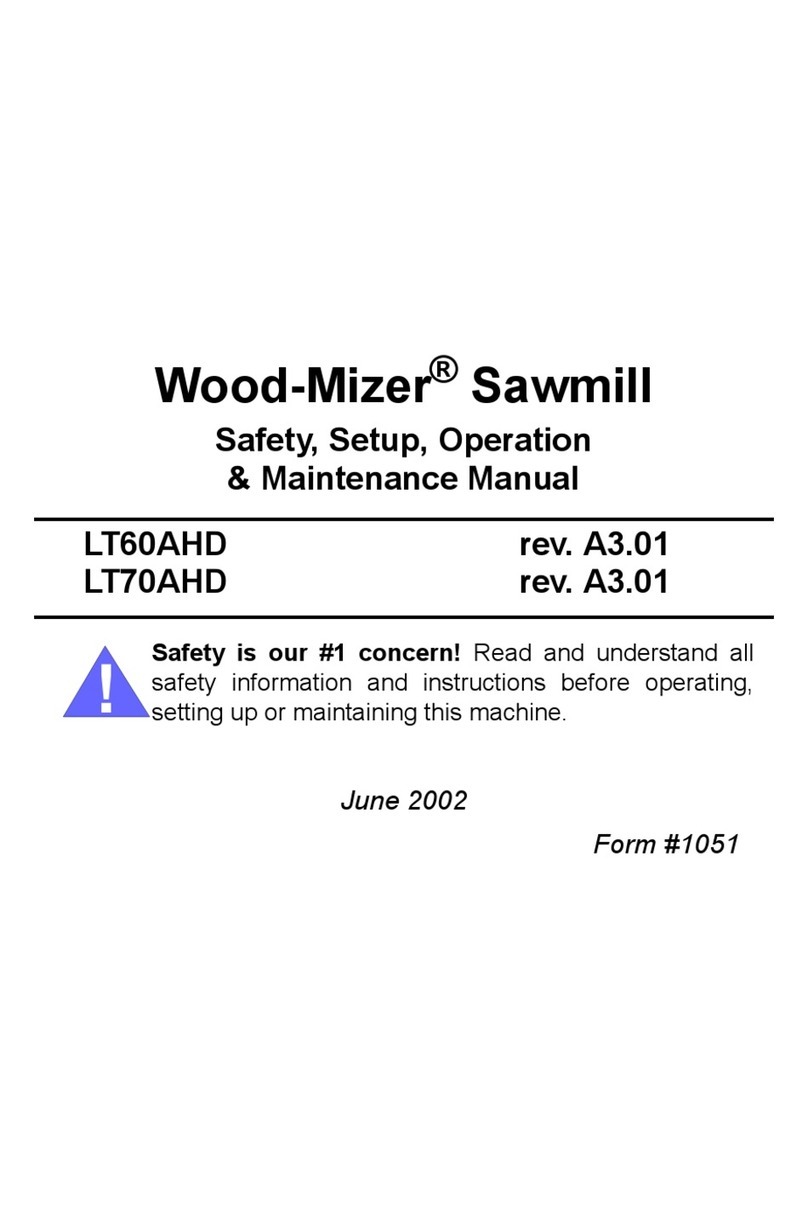
woodmizer
woodmizer LT60AHD Safety, Setup, Operation & Maintenance Manual
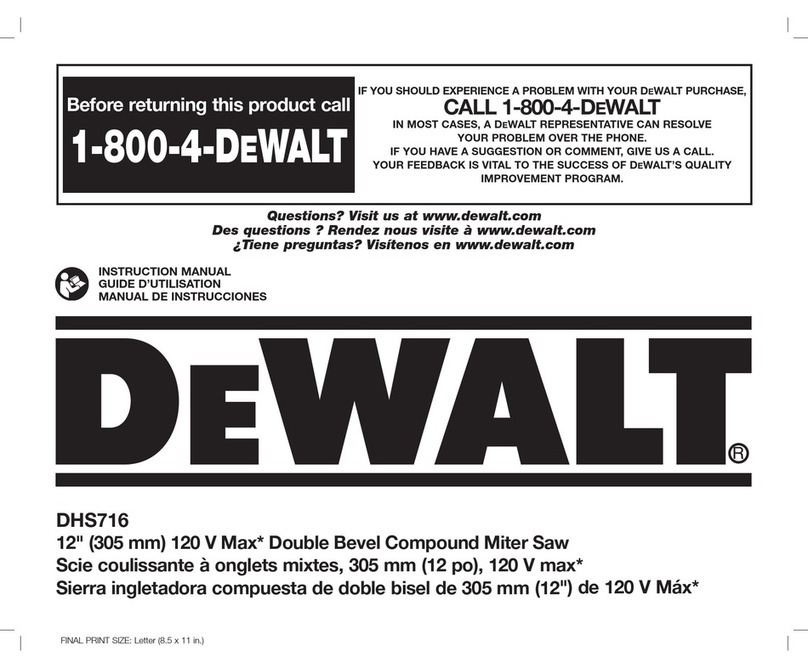
DeWalt
DeWalt DHS716 instruction manual

Chicago Electric
Chicago Electric 94626 operating instructions

QEP
QEP 60020 Owner's manual and parts list

Craftsman
Craftsman 315.220100 Operator's manual
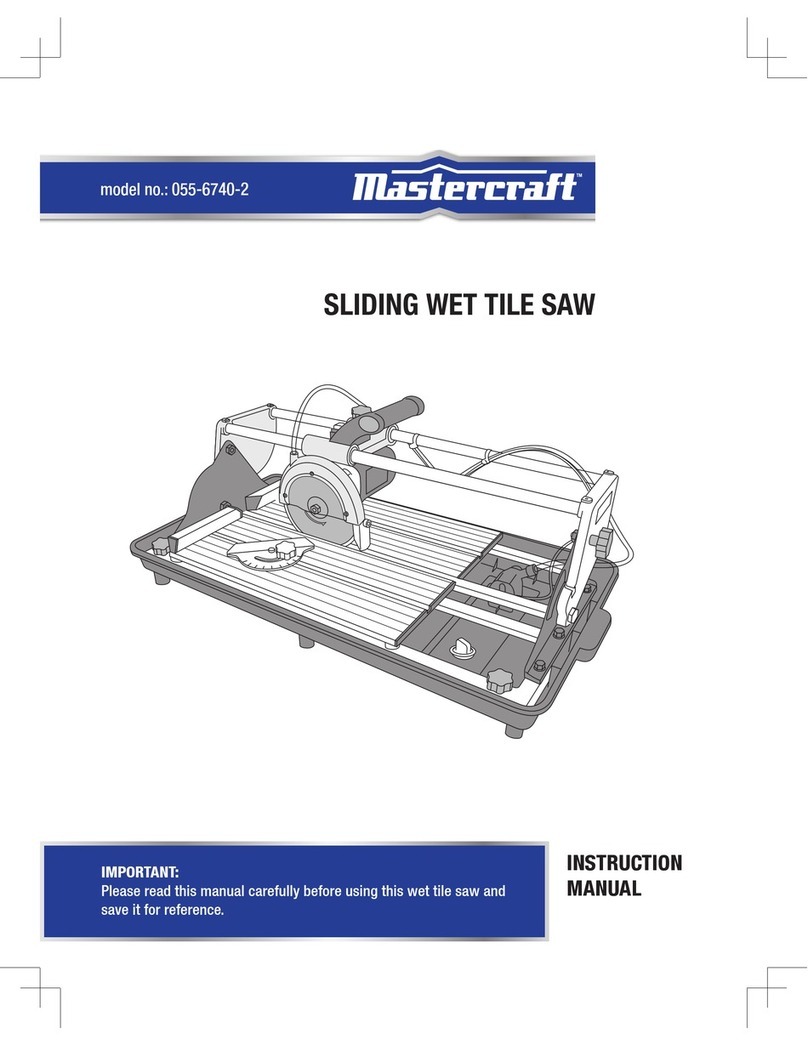
MasterCraft
MasterCraft 055-6740-2 instruction manual


